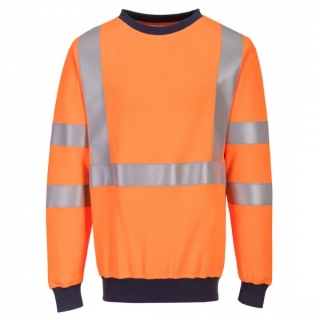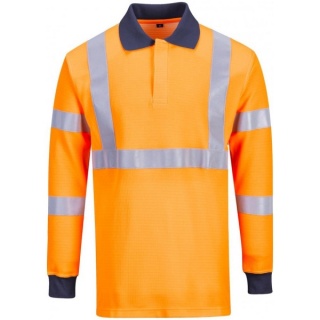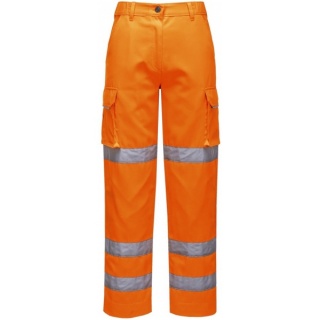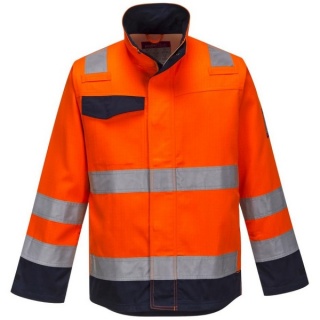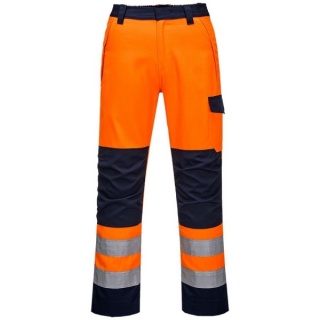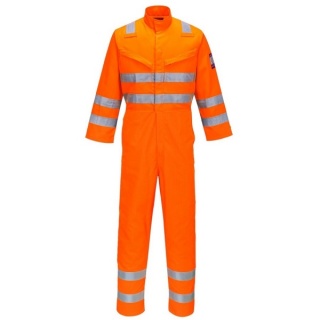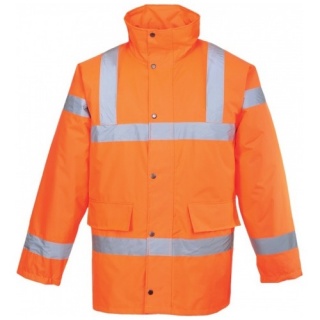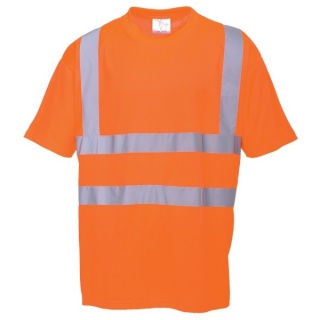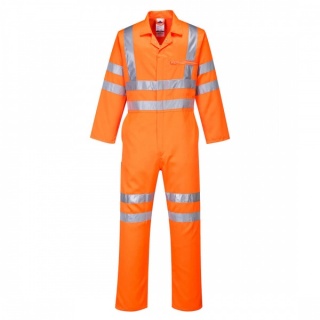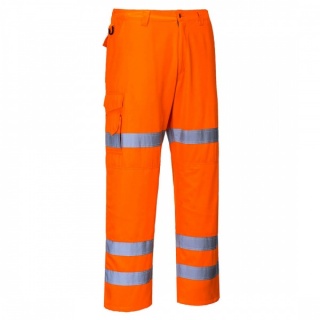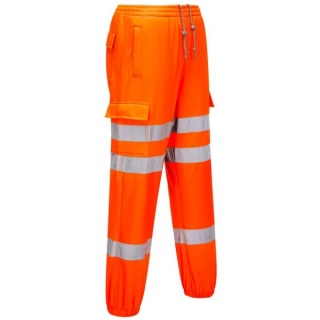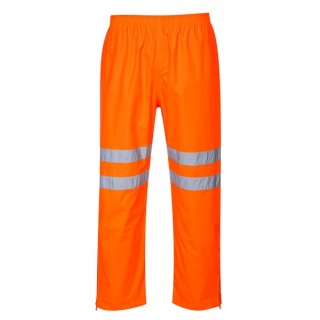Product Technical Information
Standards
- EN ISO 11612 A1+A2, B1, C1, F1
- EN ISO 11611 Class 1 A1+A2
- EN 1149 -5
- IEC 61482-2 IEC 61482-1-1 Elim 7 CAL/CM²
- IEC 61482-2 IEC 61482-1-2 APC 1
- EN 13034 Type 6
- EN ISO 20471 Class 3
- RIS 3279 TOM Issue 2 (Orange Only)
- ASTM F1959/F1959M-14e1 ATPV 8.1 CAL/CM² (HAF 73%)
Washcare
Documentation
EN ISO 11612: 2008 - Protective Clothing Against Heat and Flame
The Performance requirements set out in this international standard are applicable to garment, which could be worn for a wide range of end uses, where the is a need for clothing with limited flame spread properties and where the used can be exposed to radiant, convective or contact heat or molton metal splashes.
This test uses standard methods and conditions to predict the performance of fabric/garment in the event of contact with heat or flames. Garment features such as seams, closures and logos must be tested as well as the fabric. Tests must be carried out on pre=treated components according to the manufacturers care label.
Specific Testing is listed below:
- Dimensional Charge
- Limited Flame Spread (A1+A2)*
- Convective Heat (B) – 3 Levels
- Radiant Heat (C) - 4 Levels
- Molten Aluminium Splash (D) – 3 Levels
- Molten Iron Splash E - 3 Levels
- Contact Heat (F) – 3 Levels (Temp 250 Degrees Celcius)
- Heat Resistance at a temperature of 180 Degrees Celcius
- Tensile Strength Must meet a minimum of 300N
- Tear Strength must meet a minimum of 15N
- Bursting Strength
- Seam Strength
Garment Design requires that coverage must be provided from the neck to the wrist and to the ankles.
Optional Testing includes water vapour resistance and manikin testing for overall burn prediction.
*This test must be carried out on fabric and seams.
EN ISO 11611: 2007 - Protective Clothing for Use in Welding and Allied Processes
The International standard specifies minimum basic safety requirements and test methods for protective clothing for use in welding and allied processes (Excluding Hand Protection).
The International Standard Specifies two classes with specific performance requirements:
Class 1 is protection against less hazardous welding techniques and situations causing lower levels of spatter and radiant heat.
Class 2 is protection against more hazardous welding techniques and situations causing higher levels of spatter and radiant heat.
EN ISO 11611 requires that protective suits completely cover the upper and lower torso, neck, arms and legs. There are a number of other design requirements which must be followed to prevent molten droplets lodging anywhere on the garment.
Testing must be carried out on pre-treated components according to the manufacturers care label.
- Tensile Strength (must meet a minimum of 400N)
- Tear Strength (Must meet a minimum of 20N)
- Bursting Strength
- Seam Strength
- Dimensional Charge
- Requirements of Leather
- Limited Flame Spread (A1+A2)*
- Molten Droplets
- Heat Transfer (Radiation)
- Electrical Resistance
*This test must be carried out on the fabric and seams.
EN1149 - 5 - Protective Clothing against the Thermal Hazards of an Electric Arc
This European Standard is part of a series of standards for test methods and requirements for electrostatic properties of protective clothing. The standard specifies material and design requirements for garments used as part of a total earthed system, to avoid incendiary discharges. The requirements may not be sufficient in oxygen enriched flammable atmospheres. This standard is not applicable for protection against mains voltages.
EN 1149 consists of the following parts:
EN 1149-1: Test Method for measurement of surface resistivty.
EN 1149-2: Test Method for measurement of the electrical resistance through a material (Vertical resistance)
EN 1149-3: Test Methods for measurement of charge decay.
EN 1149-4: Garment Test (under development)
EN 1149-5: Material Performance and design requirements.
Electrostatics dissipative protective clothing shall be able to permanently cover all non-complying materials during normal use. Conductives parts (Zips, Buttons etc) are permitted provided they are cover by the outermost material when in use.
EN ISO 20471 - High Visibility Clothing
This International Standard Specifies requirements for high visibility clothing, which is capable of visually signalling the user’s presence. The high visibility clothing is intended to provide conspicuity of the wearer in any light condition when viewed by the operators of vehicles or other mechanised equipment during daylight conditions and under illumination of headlights in the dark.
High Visibility clothing has a fluorescent surface, combined with reflective material that meets certification requirements in 3 different classes:
Class 3 - Highest Level
Required for any persons working on or near motorways/dual carriageways or airports. Must incorporate a minimum of 0.80m sq of background materials and 0.20m sq of retro-reflective materials. (4 metres of 5cm wide reflective tape)
Class 2 - Intermediate Level
Required for any person working on or near A and B Roads, also for delivery drivers. Must incorporate a minimum of 0.50m sq of background material and 0.13m sq of retro-reflective material. (2.60 metres of 5cm wide reflective tape)
Class 1 - Minimum Level
Minimum level of protection required for any persons working on a private road or to be sed in conjunction with a higher classed garment. Must incorporate a minimum of 0.14m sq of background material and 0.10m sq of retro-reflective material. (2 metres of 5cm wide reflective tape)
EN 13034:2005 - Protective Clothing Against Liquid Chemicals
Performance requirements for chemical protective clothing offering limited protective performance against liquid chemicals (Type 6 and Type PB [6] equipment). This stamdard specifies the minimum requirements for limiter use and re-useable limited performance chemical protective clothing. Limited performance chemical protective clothing is intended for use in cases of a potential exposure to a light spray, liquid aerosols or low pressure, low volume splashes, against which a complete liquid permeation barrier (at a molecular level) is not required.
The Standard covers both chemical protective suits (Type 6) and partial body protection (Type PB [6]).
Type 6 suits are tested using a mist or fine spray of water with a dye added to aid the assessment of leakage. The test subject wears an absorbent suit underneath the one to be tested, which absorbs any leaks and is stained by the dye.
Success or failure is determined by measuring the total area of any stains on three suits and comparing this with the requirement. A range of other tests is specified, including resistance to abrasion, tear strength, tensile strength, resistance to puncture, resistance to ignition, resistance to penetration by liquid chemicals and seam strength. In the test for liquid chemical repellency and resistance to penetration by liquid chemicals, a bank of four test chemicals is given in the standard although the requirement is that the suit material demonstrates adequate repellency and resistance to penetration against one chemical from the list.
IEC 61482-2: 2009 - Protective Clothing Against The Thermal Hazards of An Electric Arc
This standard specifies requirements and test methods applicable to materials and garments for protective clothing against the thermal effects of an electric arc event. An electric arc is a continuous electric discharge of high current between conductors generating very bright light and intensive heat.
Two international test methods have been developed to provide information on the resistance of clothing to the thermal effects of electric arcs. Each method gives different information. To comply with our standard either or both tests must be carried out.
Box Method EN 61482-1-2
The fabric/garment is exposed to an electric arc confined in a specific box with a specific electrode arrangement for 0.5 seconds. Class 1 is to the current of 4kA arc, Class 2 is to a current 7 kA arc. Test conditions for Class 1 and 2 try to stimulate typical exposure conditions for a short circuit current of 4kA and 7kA respectively.
Open Arc Method EN61482-1-1
This test method aims to establish the ATPV (Arc Thermal Performance Value) of Ebt (Energy Breakopen Threshold) of a fabric. The APTV is the amount of energy required to cause a 2nd degree burn through the material prior to breakopen (50% probability). The EBT is the amount of energy where the material breaks-open (50% probability). This is normally the upper thermal limit of the fabric where the fibres are damaged and material loses mechanical strength, Both APTV and Ebt are expressed in calories per cm2.
RIS-3279-TOM - Railway Group Standard
RIS imposes a higher concentration for high visibility orange fabric for railway workers. This increases the conspicuous nature of the fabric and ensures that the rail worker is more visible.
RIS-3279-TOM ISSUE 1
This is a railway group standard that specifies the minimum specification for high-visibility warning clothing in the UK rail industry, ensuring workers are conspicuous when on or near railway lines.
Is based on the European standard EN ISO 20471. It defines the minimum areas of high-visibility orange background materials to be used within a garment and the minimum level of photometric performance criteria for the reflective tape. The standard requires a reflective tape reading of ≥ 330 (cd/ lx.m2) however at Portwest we insist on a reading of ≥ 400 (cd/ lx.m2).
Imposes a higher concentration for high-visibility orange fabric for railway workers. This increases the conspicuous nature of the fabric and ensures the rail worker is more visible. A spectrophotometer is used to check the chromaticity (colour intensity) of the orange high-visibility fabric. Portwest check every roll of fabric to ensure the fabric meets the requirements of RIS-3279-TOM.
ASTM F1959/F1959M-14e1 - Standard Test Method for Determining the Arc Rating of Materials for Clothing
Significance and Use
5.1 This test method is intended for the determination of the arc rating of a material, or a combination of materials.
5.1.1 Because of the variability of the arc exposure, different heat transmission values may be observed at individual sensors. Evaluate the results of each sensor in accordance with Section 12.
5.2 This test method maintains the specimen in a static, vertical position and does not involve movement except that resulting from the exposure.
5.3 This test method specifies a standard set of exposure conditions. Different exposure conditions may produce different results. In addition to the standard set of exposure conditions, other conditions representative of the expected hazard may be used and shall be documented in the reporting of the testing results.
Scope
1.1 This test method is used to measure the arc rating of materials intended for use as flame resistant clothing for workers exposed to electric arcs that would generate heat flux rates from 84 to 25 120 kW/m2 [2 to 600 cal/cm2s].
1.2 This test method will measure the arc rating of materials which meet the following requirements: less than 150 mm [6 in.] char length and less than 2 s afterflame when tested in accordance with Test Method D6413.
1.2.1 It is not the intent of this test method to evaluate non flame-resistant materials except where used as under layers in multiple-layer specimens.
1.3 The materials used in this test method are in the form of flat specimens.
1.4 This test method shall be used to measure and describe the properties of materials, products, or assemblies in response to convective and radiant energy generated by an electric arc under controlled laboratory conditions.
1.5 The values stated in SI units shall be regarded as standard except as noted. Within the text, alternate units are shown in brackets. The values stated in each system may not be exact equivalents therefore alternate systems must be used independently of the other. Combining values from the systems described in the text may result in nonconformance with the method.
1.6 This test method does not apply to electrical contact or electrical shock hazards.
1.7 This standard shall not be used to describe or appraise the fire hazard or fire risk of materials, products, or assemblies under actual fire conditions. However, results of this test may be used as elements of a fire assessment which takes into account all of the factors which are pertinent to an assessment of the fire hazard of a particular end use.
1.8 This standard does not purport to address all of the safety concerns, if any, associated with its use. It is the responsibility of the user of this standard to establish appropriate safety and health practices and determine the applicability of regulatory requirements prior to use. For specific precautions, see Section 7.
RIS-3279-TOM - Railway Standard - Orange Only
The RIS-3279-TOM standard is a specification relevant to the UK rail industry, particularly concerning the visibility of railway workers on or near the tracks. This standard is an update and extension of previous guidelines aimed at ensuring that all personnel are highly visible, thereby reducing the risk of accidents and enhancing safety.
Key Points of RIS-3279-TOM:
-
High Visibility Clothing The standard mandates specific types of high-visibility clothing that railway workers must wear. This clothing is designed to make workers easily seen by train drivers and other railway staff, especially in low light conditions or where there is a background that might otherwise camouflage them.
-
Colour Specification One of the notable aspects of RIS-3279-TOM is the specification of an orange color for high-visibility clothing. This color is chosen for its effectiveness in standing out against most backgrounds, particularly in the varied environments found along railways.
-
Compliance Requirements The standard sets out detailed requirements for the design and material of high-visibility clothing, including retroreflective properties and minimum areas of visible material. It ensures that the clothing meets specific safety standards and performance requirements under various conditions, such as in wet weather.
-
Application and Enforcement RIS-3279-TOM is applicable to all workers within the UK rail industry who might be at risk from moving vehicles, including trains. The standard is enforced by railway operators and contractors, who must ensure that all personnel are equipped with compliant high-visibility clothing.
-
Updates and Revisions As an evolution of previous standards (notably the GO/RT 3279, which it replaced), RIS-3279-TOM reflects the latest understanding and technology in high-visibility clothing. It may be updated or revised as new information becomes available or as working conditions change.
Importance of RIS-3279-TOM
The RIS-3279-TOM standard is crucial for the safety of railway workers. By specifying requirements for high-visibility clothing, it plays a vital role in preventing accidents and injuries on the railways. Compliance with the standard is a key aspect of risk management and safety protocols within the UK rail industry, ensuring that workers are visible at all times and reducing the likelihood of accidents.
